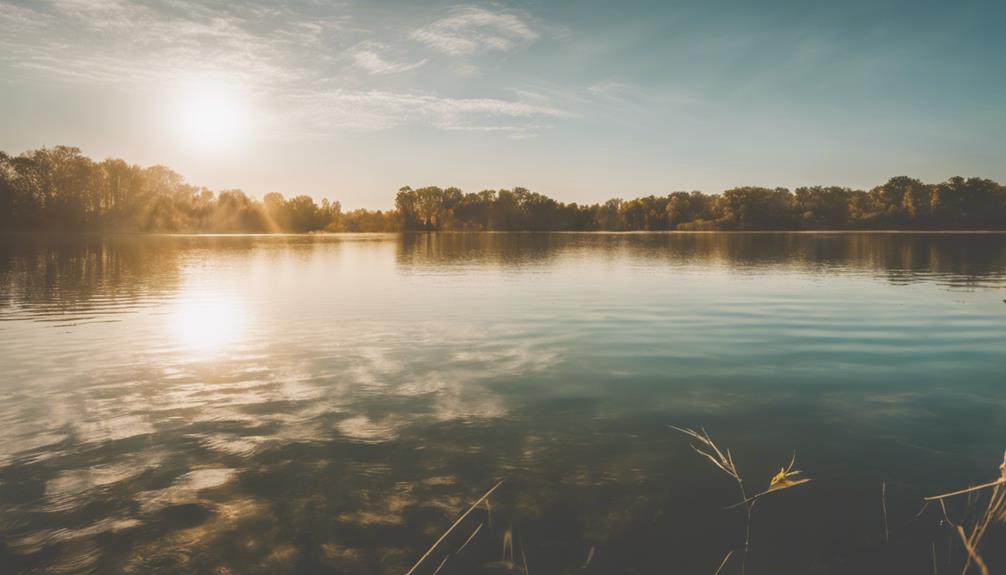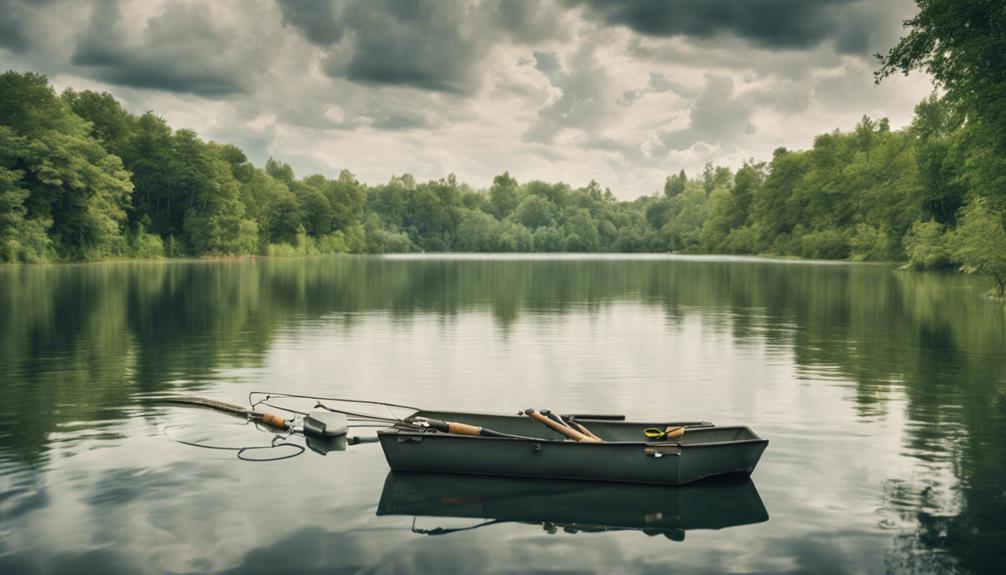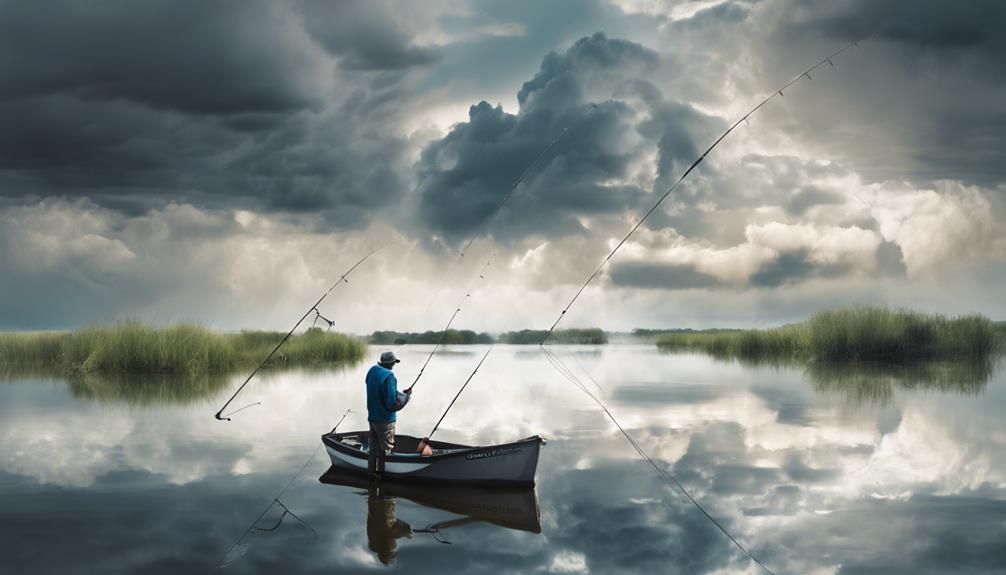Weather significantly influences your fishing success rate by affecting fish behavior and feeding patterns. Factors like barometric pressure, wind direction, temperature changes, and sunlight intensity play crucial roles. Advanced weather forecasting tools help adjust your fishing strategy based on upcoming conditions. Understanding how fish react to pressure changes, wind speed, and cloud cover can enhance your chances of a successful catch. By adapting your techniques to suit seasonal weather variations and staying informed on forecasts, you can maximize your fishing outcomes. Mastering the interplay between weather and fishing can lead to more rewarding angling experiences.
Understanding Weather Patterns for Fishing
To maximize your fishing success, it's crucial to understand how weather patterns directly impact fish behavior and feeding habits. Weather forecasting techniques and fishermen's intuition play a significant role in determining the ideal conditions for a successful fishing trip.
Weather forecasting techniques provide valuable insights into upcoming weather patterns, such as changes in barometric pressure, temperature shifts, and precipitation. Fish are highly sensitive to these variations, adjusting their behavior accordingly. For example, a sudden drop in barometric pressure often indicates an approaching storm, causing fish to become more active and feed aggressively before the weather changes. By utilizing advanced weather forecasting tools, you can anticipate these fluctuations and adjust your fishing strategy accordingly.
In addition to scientific forecasting methods, many experienced anglers rely on their intuition to gauge weather conditions and predict fish behavior. This intuition is often developed through years of observation and hands-on experience on the water. Paying attention to subtle signs, such as the movement of clouds, the direction of the wind, and the behavior of birds, can provide valuable clues about the best times to fish. By combining weather forecasting techniques with your own intuition, you can increase your chances of a successful fishing outing.
Impact of Wind on Fishing Success
Wind direction and intensity significantly influence fishing success by directly impacting fish behavior and feeding patterns. When the wind blows parallel to the shore, it pushes the surface water, causing colder, nutrient-rich water to rise from the depths, attracting baitfish and, consequently, larger predatory fish. On the other hand, a perpendicular wind creates choppy waters, making it harder for fish to see bait, thus reducing feeding activity. Therefore, understanding wind direction is crucial for positioning yourself effectively.
Wind speed also plays a key role in fishing success. Higher wind speeds can oxygenate the water, stimulating fish activity. However, excessively strong winds can create turbulent conditions, making it challenging to keep your bait in the desired spot. It's recommended to use heavier sinkers or lures to combat this issue. Conversely, very low wind speeds can lead to calm waters, which might make fish more cautious and less likely to feed aggressively.
Importance of Cloud Cover in Fishing
Cloud cover significantly impacts fishing success by influencing light penetration into the water column, which in turn affects fish behavior and feeding habits. The dynamics of cloud cover play a crucial role in determining the amount of light that reaches different depths in the water. When fishing under overcast skies, the reduced light intensity can lead to changes in fish activity levels.
Cloud cover dynamics vary from light wispy clouds to thick, dark clouds that completely block out the sun. Light cloud cover may create dappled lighting conditions that can attract certain fish species to the shallows, while heavier cloud cover can cause fish to move to deeper waters or seek shelter near structures.
Fishing under overcast skies can sometimes improve catch rates, as the diffused light reduces glare on the water surface, making it easier for fish to spot prey. However, excessively dark clouds and impending storms can have the opposite effect, causing fish to become more cautious and less likely to feed.
Understanding how cloud cover influences fish behavior is essential for adapting your fishing techniques accordingly. Paying attention to cloud patterns and their effects on light penetration can help you make informed decisions about where and how to fish for optimal results.
Rainfall and Fishing: What You Need to Know
Rainfall impacts fishing success by altering water conditions and fish behavior, ultimately influencing catch rates. When it rains, the water temperature can decrease due to the influx of cold rainwater. This temperature drop can affect fish metabolism, leading them to be less active and feed less, making them harder to catch. Additionally, rainfall can dilute the salinity of saltwater bodies, affecting the distribution of fish species and their feeding patterns.
Humidity levels also play a crucial role in fishing during rainfall. High humidity can affect angler comfort and decrease the overall fishing experience. It can make handling equipment more challenging and lead to discomfort, potentially reducing the time an angler spends on the water.
Storm conditions accompanying heavy rainfall can pose safety hazards for anglers. Lightning strikes and strong winds are common during storms, endangering those fishing from boats or exposed areas. It's essential to prioritize safety and monitor weather forecasts to avoid dangerous situations while fishing in stormy conditions.
Understanding the impact of rainfall on fishing is vital for anglers to adjust their strategies accordingly. By considering water temperature changes, humidity levels, and storm conditions, anglers can make informed decisions to optimize their fishing success even during challenging weather conditions.
Effect of Temperature Changes on Fish Behavior
Temperature fluctuations significantly impact the behavior of fish, leading to observable changes in their feeding habits and movement patterns. When the water temperature rises, fish tend to become more active and feed more frequently. This increase in activity is primarily due to the fact that warmer water leads to higher metabolic rates in fish, requiring them to consume more food to sustain their energy levels. On the other hand, a decrease in water temperature can result in fish being less active and feeding less often.
Water clarity plays a crucial role in how fish respond to temperature changes. Clear water tends to heat up and cool down more quickly than murky water. Therefore, in clearer waters, fish may be more sensitive to abrupt temperature shifts and could potentially alter their behavior more noticeably.
Moreover, oxygen levels in the water are intricately linked to temperature. Warmer water holds less dissolved oxygen than cooler water, which can influence where fish congregate and how actively they feed. In situations where temperature fluctuations lead to decreased oxygen levels, fish may move to shallower areas where oxygen is more abundant, affecting their feeding patterns.
Understanding how fish behavior changes in response to temperature fluctuations, water clarity, and oxygen levels is vital for maximizing your fishing success. By considering these factors when planning your fishing trips, you can adapt your strategies accordingly and increase your chances of a fruitful catch.
Barometric Pressure and Fishing Results
Water pressure fluctuations, particularly barometric changes, are known to significantly influence fishing outcomes due to their impact on fish behavior and activity levels. Barometric pressure refers to the weight of the atmosphere above a specific point, affecting the pressure exerted on bodies of water and subsequently influencing fish behavior. Understanding the relationship between barometric pressure and fishing can enhance your fishing techniques and success rate. Here are five key points to consider:
- High Pressure: Fish tend to be more lethargic during high barometric pressure, making them less active and reducing their feeding behavior.
- Low Pressure: Conversely, low barometric pressure can trigger increased fish activity as they sense an opportunity to feed more actively.
- Stable Pressure: Fish often prefer stable barometric conditions, where they're more predictable in their behavior and feeding patterns.
- Pressure Changes: Rapid changes in barometric pressure, especially falling pressure, can stimulate fish to feed more aggressively.
- Adaptation: Successful anglers adapt their fishing techniques based on barometric pressure changes, such as adjusting bait presentation or fishing at different depths to entice bites effectively.
How Sunlight Levels Influence Fishing Outcomes

Sunlight intensity directly impacts fish behavior and feeding patterns, playing a crucial role in determining fishing success. The solar angle, which is the angle of the sun relative to the horizon, influences the amount of sunlight reaching the water's surface. Fish species have varying preferences for light levels. For instance, species like bass and trout are often more active during low light conditions such as early morning or late evening when the solar angle is low. In contrast, species like snapper tend to be more active during brighter conditions when the sun is directly overhead.
Daylight duration is another key factor influenced by sunlight levels. Longer daylight hours during summer months can lead to increased feeding activity as fish have more time to forage. However, during shorter daylight hours in winter, fish may feed less frequently and in different locations. Understanding these patterns can significantly improve your fishing outcomes.
To optimize your fishing success based on sunlight levels, consider the time of day and season. For species that prefer low light, dawn and dusk are prime times for fishing. In contrast, for species that thrive in bright conditions, midday may yield better results. By aligning your fishing trips with the solar angle and daylight duration preferences of your target species, you can enhance your chances of a successful catch.
Seasonal Weather Variations and Fishing Strategies
Understanding the impact of seasonal weather variations on fish behavior is key to developing effective fishing strategies for maximizing your catch. Seasonal changes can significantly alter water clarity, directly influencing fish behavior. When planning your fishing trips, consider the following factors:
- Water Clarity: Pay attention to how seasonal weather variations affect water clarity in your fishing area. Fish may react differently depending on whether the water is clear or murky.
- Fish Behavior: Understand how fish behavior shifts with the changing seasons. Different species may exhibit varying feeding patterns and movement in response to seasonal weather variations.
- Tidal Currents: Take into account how tidal currents are influenced by seasonal weather patterns. Tidal movements can impact where fish congregate and feed.
- Fishing Techniques: Adapt your fishing techniques to suit the seasonal weather variations. Experiment with different baits, lures, and presentation styles to match the behavior of fish during each season.
- Stay Informed: Stay updated on seasonal weather forecasts and how they may affect fishing conditions. Being aware of upcoming weather changes can help you plan your fishing trips more effectively.
Frequently Asked Questions
Can Fishing Success Be Affected by the Lunar Phases?
Yes, fishing success can be affected by lunar phases. Understanding lunar cycles is key to predicting fish behavior.
Different moon phases can influence fish activity levels and feeding patterns. Anglers often adjust their fishing techniques based on the moon phases to increase their chances of success.
How Does Humidity Impact Fish Activity?
When humidity rises, fish may become more active due to the potential increase in water temperature. This change can influence their behavior, making them more likely to feed.
Additionally, high humidity levels are often associated with low barometric pressure, which can also impact fish feeding habits.
Therefore, understanding how humidity affects fish activity can be crucial in predicting their behavior and optimizing your chances of a successful fishing trip.
Is There a Correlation Between Fishing and Air Pollution Levels?
When examining the correlation between fishing success and air pollution levels, environmental factors play a crucial role. High levels of air pollution can have detrimental effects on water quality and aquatic life, ultimately impacting fish behavior and abundance.
Monitoring air pollution levels in conjunction with other environmental variables can provide valuable insights into how these factors collectively influence fishing success rates. Understanding these relationships can help anglers make more informed decisions when planning fishing trips.
Do Fish Respond Differently to Thunderstorms?
During thunderstorms, fish may respond differently due to factors like lightning strikes and changes in barometric pressure.
Lightning can cause fish to become more skittish and retreat to deeper waters for safety. Additionally, the drop in barometric pressure associated with thunderstorms can affect fish behavior, potentially making them less active.
These environmental changes during storms can influence where and how fish are feeding, impacting your fishing success rate.
What Role Do Ocean Currents Play in Fishing Outcomes?
Ocean currents play a crucial role in determining fishing outcomes. These currents influence water temperature, nutrient distribution, and fish migration patterns. By understanding ocean currents, you can predict where fish might gather, increasing your fishing success.
Additionally, ocean currents interact with lunar phases, affecting fish behavior and activity levels. Factors like humidity impact fishing conditions, making it essential to consider all variables for a successful fishing excursion.
Conclusion
In conclusion, understanding how weather influences fishing success is crucial for anglers looking to improve their catch rates.
By analyzing weather patterns, wind conditions, cloud cover, rainfall, temperature changes, barometric pressure, sunlight levels, and seasonal variations, you can adapt your fishing strategies accordingly.
Utilizing this data-driven approach will help you make informed decisions on when and where to fish, ultimately leading to more successful outcomes on the water.



